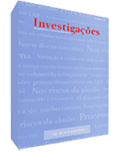A Presença da Metáfora no Discurso Jornalístico
Abstract
Objetivamos, neste trabalho, caracterizar e ressaltar a relevância das metáforas nos textos jornalísticos a partir do diálogo entre os estudos da Análise do Discurso e da Lingüística Cognitiva. Constituímos o corpus com textos dos jornais Folha de S. Paulo e O Estado de S. Paulo e o analisamos conforme as teorias citadas. Verificamos que as metáforas são usadas como meio de persuasão.
References
ALTHUSSER, Louis. 1980. Ideologia e Aparelhos Ideológicos do Estado. 3. ed. Lisboa: Editorial Presença; Martins Fontes.
FOUCAULT, Michel. 2002. A ordem do discurso. 8. ed. São Paulo: Edições Loyola.
JOANILHO, Mariângela Peccioli Galli. 2005. As metáforas da língua
nacional. Tese de Doutorado. Campinas, SP: UNICAMP.
LAKOFF, George; Johnson, Mark. 2002 Metáforas da Vida Cotidiana. São Paulo: Educ.
MAINGUENEAU, Dominique. 1993. Novas tendências em Análise do
Discurso. 2. ed. Campinas, SP: Pontes; Editora da UNICAMP.
______. 2002. Análise de textos de comunicação. São Paulo: Cortez.
MALDIDIER, Denise. 1997. Elementos pra uma história da Análise do
discurso na França. In: Orlandi, Eni Puccinelli (org). Gestos de leitura: da
história no discurso. 2. ed. Campinas, SP: Editora da UNICAMP.
MARTINS, Nilce Sant’anna. 1997. Introdução à Estilística. 2. ed. São
Paulo: T.A Queiroz.
ORLANDI, Eni Puccinelli. 1999. Discurso e leitura. São Paulo: Cortez.
Pêcheux, Michel. 1997. Semântica e discurso: uma crítica à afirmação do
óbvio. 3. ed. Campinas, SP: Editora da UNICAMP.
PONTES, Eunice. 1990. O “continuum” língua oral e língua escrita: por
uma nova concepção do ensino. In: Pontes, Eunice (org). A Metáfora. Campinas, SP: Editora da UNICAMP.
Downloads
Published
How to Cite
Issue
Section
License
Copyright (c) 2007 Luciana Soares da Silva

This work is licensed under a Creative Commons Attribution 4.0 International License.
Authors who publish with Revista Investigações agree to the following terms:
Authors retain copyright and grant the journal right of first publication with the work simultaneously licensed under the Creative Commons Attribution 4.0 International (CC BY 4.0) license that allows others to share the work with an acknowledgement of the work's authorship and initial publication in this journal.
Authors are able to enter into separate, additional contractual arrangements for the non-exclusive distribution of the journal's published version of the work (e.g., post it to an institutional repository or publish it in a book), with an acknowledgement of its initial publication in this journal.
You are free to:
Share — copy and redistribute the material in any medium or format for any purpose, even commercially.
Adapt — remix, transform, and build upon the material for any purpose, even commercially.
The licensor cannot revoke these freedoms as long as you follow the license terms.
Under the following terms:
Attribution — You must give appropriate credit , provide a link to the license, and indicate if changes were made . You may do so in any reasonable manner, but not in any way that suggests the licensor endorses you or your use.
No additional restrictions — You may not apply legal terms or technological measures that legally restrict others from doing anything the license permits.

